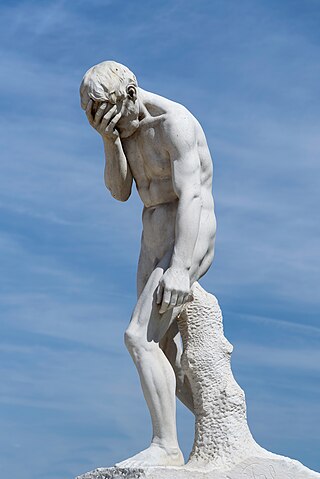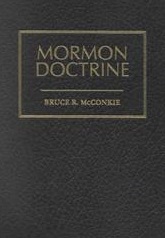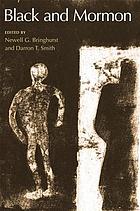Related Research Articles

The Church of Jesus Christ of Latter-day Saints, informally known as the LDS Church or Mormon Church, is a restorationist, nontrinitarian Christian denomination that is the largest denomination in the Latter Day Saint movement. The church is headquartered in the United States in Salt Lake City, Utah and has established congregations and built temples worldwide. According to the church, it has over 17 million members and over 99 thousand volunteer missionaries. As of 2012, the church was the fourth-largest Christian denomination in the U.S. As of 2023, the church reported over 6.8 million U.S. members.
Early Mormonism had a range of doctrines related to race with regards to Black people of African descent. References to Black people, their social condition during the 19th and 20th centuries, and their spiritual place in Western Christianity as well as in Mormon scripture were complicated.

Elijah Abel, or Able or Ables was one of the earliest African-American members of the Church of Jesus Christ of Latter-day Saints, and was the church's first African-American elder and Seventy. Abel was predominantly of Scottish and English descent and appears to have been the first, and one of the few, black members in the early history of the church to have received Priesthood ordination, later becoming the faith's first black missionary. Abel did not have his ordination revoked when the LDS Church officially announced its now-obsolete restrictions on Priesthood ordination, but was denied a chance to receive his temple endowment by third church president John Taylor. As a skilled carpenter, Abel often committed his services to the building of LDS temples and chapels. He died in 1884 after serving a mission to Cincinnati, Ohio, his last of three total missions for the church.
During the history of the Latter Day Saint movement, the relationship between Black people and Mormonism has included enslavement, exclusion and inclusion, and official and unofficial discrimination. Black people have been involved with the Latter Day Saint movement since its inception in the 1830s. Their experiences have varied widely, depending on the denomination within Mormonism and the time of their involvement. From the mid-1800s to 1978, Mormonism's largest denomination – the Church of Jesus Christ of Latter-day Saints – barred Black women and men from participating in the ordinances of its temples necessary for the highest level of salvation, prevented most men of Black African descent from being ordained into the church's lay, all-male priesthood, supported racial segregation in its communities and schools, taught that righteous Black people would be made white after death, and opposed interracial marriage. The temple and priesthood racial restrictions were lifted by church leaders in 1978. In 2013, the church disavowed its previous teachings on race for the first time.

In Latter-day Saint theology, Egyptus is the name of two women in the Book of Abraham in the Pearl of Great Price. One is the wife of Ham, son of Noah, who bears his children. The other is their daughter, who discovered Egypt while "it was under water" (1:23-24). Three 1835 pre-publication manuscripts of the Book of Abraham, in place of "Egyptus", read Zeptah for the elder Egyptus and Egyptes for the younger Egyptus.

The curse of Cain and the mark of Cain are phrases that originated in the story of Cain and Abel in the Book of Genesis. In the stories, if someone harmed Cain, the damage would come back sevenfold. Some interpretations view this as a physical mark, whereas other interpretations see the "mark" as a sign, and not as a physical mark on Cain himself. The King James Version of the Bible reads "set a mark upon Cain".

In the Book of Genesis, the curse of Ham is described as a curse which was imposed upon Ham's son Canaan by the patriarch Noah. It occurs in the context of Noah's drunkenness and it is provoked by a shameful act that was perpetrated by Noah's son Ham, who "saw the nakedness of his father". The exact nature of Ham's transgression and the reason Noah cursed Canaan when Ham had sinned have been debated for over 2,000 years.
The teachings of Joseph Smith include a broad spectrum of religious doctrines as well as political and scientific ideas and theories, many of which he said were revealed to him by God. Joseph Smith is the founder of the Latter Day Saint movement and is recognized by multiple Latter Day Saint churches as the founder. Beginning in 1828, Smith began dictating the text of what later became the Book of Mormon, and also began dictating written revelations he said were inspired by God.

Mormon Doctrine is an encyclopedic work written in 1958 by Bruce R. McConkie, a general authority of the Church of Jesus Christ of Latter-day Saints. It was intended primarily for a Latter-day Saint audience and has been used as a reference book by church members because of its comprehensive nature, and was a highly influential all-time bestseller in the LDS community. It was viewed by many members both then and now as representing official doctrine despite never being endorsed by the church. It has been both heavily criticized by some church leaders and members and well regarded by others. After the book's first edition was removed from publication at the instruction of the church's First Presidency and Quorum of the Twelve, corrections were made in subsequent editions. The book went through three editions but has been out of print since 2010.

The 1978 Revelation on Priesthood was an announcement by leaders of the Church of Jesus Christ of Latter-day Saints that reversed a long-standing policy excluding men of Black African descent from ordination to the denomination's priesthood and both Black men and women from priesthood ordinances in the temple. Leaders stated it was a revelation from God.
From 1852 to 1978, temple and priesthood policies in the Church of Jesus Christ of Latter-day Saints prohibited both Black women and Black men from temple ordinances and ordination in the all-male priesthood. In 1978, the church's highest governing body, the First Presidency, declared in the statement "Official Declaration 2" that the restriction had been lifted. Between 1830 and 1852, a few Black men had been ordained to the Mormon priesthood in the Latter Day Saint movement under Joseph Smith.

Since Mormonism's foundation, Black people have been members, however the church placed restrictions on proselytization efforts among Black people. Before 1978, Black membership was small. It has since grown, and in 1997, there were approximately 500,000 Black members of the church, mostly in Africa, Brazil and the Caribbean. Black membership has continued to grow substantially, especially in West Africa, where two temples have been built. By 2018, an estimated 6% of members were Black worldwide. In the United States, approximately 1% of members are Black.

The Latter Day Saint movement has had varying and conflicting teachings on slavery. Early converts were initially from the Northern United States and opposed slavery, believing that their opposition was supported by Mormon scripture. After the church base moved to the slave state of Missouri and gained Southern converts, church leaders began to enslave people. New scriptures instructing Latter-Day Saints not to intervene in the lives of the enslaved people were revealed. A few enslavers joined the church, and when they moved to Nauvoo, Illinois, they illegally took their enslaved people with them, even though Illinois was a free state.

Black and Mormon is a 2004 book edited, with an introduction, by Newell G. Bringhurst and Darron T. Smith. It is a collection of articles about Black people and Mormonism, race and the LDS priesthood, and the experience of Black Mormons.
Newell G. Bringhurst is an American historian and author of books and essays. Most of his writings have been about Mormonism— particularly topics and figures of controversy, such as blacks and the priesthood, Fawn Brodie, polygamy, and schisms within the LDS movement
In the past, leaders of the Church of Jesus Christ of Latter-day Saints have consistently opposed marriages between members of different ethnicities, though interracial marriage is no longer considered a sin. In 1977, apostle Boyd K. Packer publicly stated that "[w]e've always counseled in the Church for our Mexican members to marry Mexicans, our Japanese members to marry Japanese, our Caucasians to marry Caucasians, our Polynesian members to marry Polynesians. ... The counsel has been wise." Nearly every decade for over a century—beginning with the church's formation in the 1830s until the 1970s—has seen some denunciations of interracial marriages (miscegenation), with most statements focusing on Black–White marriages. Church president Brigham Young taught on multiple occasions that Black–White marriage merited death for the couple and their children.
Civil rights and Mormonism have been intertwined since the religion's start, with founder Joseph Smith writing on slavery in 1836. Initial Mormon converts were from the north of the United States and opposed slavery. This caused contention in the slave state of Missouri, and the church began distancing itself from abolitionism and justifying slavery based on the Bible. During this time, several slave owners joined the church, and brought their enslaved people with them when they moved to Nauvoo, Illinois. The church adopted scriptures which teach against influencing slaves to be "dissatisfied with their condition" as well as scriptures which teach that "all are alike unto God." As mayor of Nauvoo, Smith prohibited Black people from holding office, joining the Nauvoo Legion, voting or marrying whites; but, as president of the church Black people became members and several Black men were ordained to the priesthood. Also during this time, Smith began his presidential campaign on a platform for the government to buy slaves into freedom over several years. He was killed during his presidential campaign.

Over the past two centuries, the relationship between Native American people and Mormonism has included friendly ties, displacement, battles, slavery, education placement programs, and official and unofficial discrimination. Native American people were historically considered a special group by adherents of the Latter Day Saint movement (Mormons) since they were believed to be the descendants of the Lamanite people described in The Book of Mormon. There is no support from genetic studies and archaeology for the historicity of the Book of Mormon or Middle Eastern origins for any Native American peoples. Today there are many Native American members of Mormon denominations as well as many people who are critical of Mormonism and its teachings and actions around Native American people.

Teachings on the biblical curse of Cain and the curse of Ham in the Church of Jesus Christ of Latter-day Saints, and their effects on Black people in the LDS Church have changed throughout the church's history. Both church founder Joseph Smith, and his most popular successor Brigham Young taught that Black people were under the curse of Ham, and the curse of Cain. Smith and Young both referred to the curses as a cause for slavery. They also taught that dark skin marked people of African ancestry as cursed by God. In Smith's revisions of the King James Bible, and production of the Book of Abraham he traced their cursed state back to the curses placed on Cain and Ham, and linked the two curses by positioning Ham's Canaanite posterity as matrilinear descendants of Cain.

Mormon teachings on skin color have evolved throughout the history of the Latter Day Saint movement, and have been the subject of controversy and criticism. Historically, in Mormonism's largest denomination the Church of Jesus Christ of Latter-day Saints, leaders beginning with founder Joseph Smith taught that dark skin was a sign of a curse from God. After his death in 1844 other leaders taught it was also a punishment for premortal unrighteousness. Since 2013, the church has officially disavowed these beliefs and now teaches that all people are equal in God's sight, regardless of skin color. The LDS Church since then has worked to promote racial equality and inclusion. Several other Mormon denominations, however continue to teach into the present day that skin color is related to curses or personal righteousness.
References
- 1 2 3 4 5 6 7 8 9 10 Bringhurst, Newell G. "Mormonism and Black Slavery: Changing Attitudes and Related Practices, 1830–1865". Greg Kofford Books. Retrieved October 26, 2020.
- 1 2 Smith, Joseph (April 1836). "For the Messenger and Advocate". The Latter Day Saints' Messenger and Advocate . 2 (7): 290 – via The Joseph Smith Papers.
After having expressed myself so freely upon this subject [of slavery], I do not doubt, but those who have been forward in raising their voices against the South, will cry out against me .... It is my privilege then to name certain passages from the Bible, and examine the teachings of the ancients upon the matter as the fact is uncontrovertible [sic] that the first mention we have of slavery is found in the Holy Bible, pronounced by a man [Noah] who was perfect in his generation, and walked with God. And so far from that prediction being averse to the mind of God, it remains as a lasting monument of the decree of Jehovah, to the shame and confusion of all who have cried out against the South, in consequence of their holding the sons of Ham in servitude. 'And he said, Cursed be Canaan; a servant of servants shall he be unto his brethren.' ... (Gen. 9:25-26). Trace the history of the world from this notable event down to this day, and you will find the fulfillment of this singular prophecy. [T]he curse is not yet taken off from the sons of Canaan, neither will be until it is affected by as great a power as caused it to come; and the people who interfere the least with the purposes of God in this matter, will come under the least condemnation before Him ....
- 1 2 3 Stuart Bingham, Ryan (July 2015). "Curses and Marks: Racial Dispensations and Dispensations of Race in Joseph Smith's Bible Revision and the Book of Abraham". Journal of Mormon History . 41 (3): 22–57. doi:10.5406/jmormhist.41.3.22. JSTOR 10.5406/jmormhist.41.3.22 – via JSTOR.
- 1 2 3 4 Reeve, W. Paul (2015). Religion of a Different Color: Race and the Mormon Struggle for Whiteness . New York, New York: Oxford University Press. ISBN 978-0-19-975407-6 – via Google Books.
- 1 2 Harris, Matthew L.; Bringhurst, Newell G. (2015). The Mormon Church and Blacks: A Documentary History . Chicago: University of Illinois Press. ISBN 978-0-252-08121-7 – via Google Books.
- ↑ Genesis 9:20–27
- ↑ Mauss, Armand L. (2003). All Abraham's Children: Changing Mormon Conceptions of Race and Lineage. University of Illinois Press. p. 213. ISBN 0-252-02803-1 – via Google Books.
At least until after Smith's death in 1844, then, there seems to have been no church policy of priesthood denial on racial grounds, and a small number of Mormon blacks were actually given the priesthood. The best known of these, Elijah Abel, received the priesthood offices of both elder and seventy, apparently in the presence of Smith himself.
- 1 2 Turner, John G. (August 18, 2012). "Why Race Is Still a Problem for Mormons". The New York Times .
- ↑ Stewart, John J. (1960). Mormonism and the Negro. p. 17 – via Google Books.
- 1 2 3 4 5 Andersen, Ty. "Break Off the Shackles From the Poor Black Man: Joseph Smith's Abolitionist Rhetoric in the 1844 Presidential Campaign". Academia.edu . Retrieved October 26, 2020.
- ↑ Brodie, Fawn M. (1995). No Man Knows My History: The Life of Joseph Smith (2nd Revised & Enlarged ed.). NY: Vintage. pp. 172–75. ISBN 978-0679730545.
- 1 2 3 Bringhurst, Newell G. (1991). "Fawn M. Brodie as a Critic of Mormonism's Policy toward Blacks—A Historiographical Reassessment". The John Whitmer Historical Association Journal . 11: 34–46. JSTOR 43200880.
- ↑ Kimball, Edward L. "Spencer W. Kimball and the Revelation on Priesthood". BYU Studies . Retrieved October 29, 2020.
- 1 2 3 4 5 Bush, Lester E. Jr.; Mauss, Armand L., eds. (1984). Neither White Nor Black: Mormon Scholars Confront the Race Issue in a Universal Church. Salt Lake City, Utah: Signature Books. ISBN 0-941214-22-2. Archived from the original on October 1, 2022.
- 1 2 3 4 Bush, Lester E. (1973). "Mormonism's Negro Doctrine: An Historical Overview" (PDF). Dialogue . 8 (1).
- ↑ Lund, John Lewis (1967). The Church and the Negro. Salt Lake City, Utah: Paramount Publishers – via Google Books.
- ↑ W. Kesler Jackson. Elijah Abel: The Life and Times of a Black Priesthood Holder. Cedar Fort. ISBN 9781462103560 – via Google Books.
- ↑ Bushman, Richard Lyman (2005). Joseph Smith: Rough Stone Rolling. New York: Alfred A. Knopf. p. 517. ISBN 1-4000-4270-4 – via Google Books.
Probably by 'confinement to their own species' he meant no intermarriage.
- ↑ Smith, George (1948). History of the Church, Vol. 5. Salt Lake City: Deseret Book. p. 217 – via BYU.
- ↑ Smith, George (1948). History of the Church, Vol. 6. Salt Lake City: Deseret Book. p. 210. Retrieved August 28, 2017– via BYU.
- ↑ Smith, Joseph. Journal, December 1842–June 1844. Vol. 3. LDS Church. 15 July 1843–29 February 1844 – via The Joseph Smith Papers.
- 1 2 "American Prophet: The Story of Joseph Smith". Public Broadcasting Service. 1999 – via YouTube.
- ↑ Embry, Jessie (1994). Black Saints in a White Church . Salt Lake City, Utah: Signature Books. ISBN 1-56085-044-2. OCLC 30156888 – via Internet Archive.
- 1 2 Smith, Joseph (1833). History of the Church. Vol. 1. Deseret Book. pp. 374–376. Retrieved June 12, 2023– via BYU.
- 1 2 Smith, Heman C. (July 1910). "Mormon Troubles in Missouri". Missouri Historical Review . 4 (4). Columbia, Missouri: State Historical Society of Missouri: 238 – via Daviess County Historical Society.
- ↑ Garr, Arnold (2007). Setting the Record Straight: Joseph Smith: Presidential Candidate. Orem UT: Millennial Press. p. 41. ISBN 978-1-932597-53-0 – via Google Books.
- ↑ Cannon, George Q. (1888). The Life of Joseph Smith the Prophet. Nova Science Publishers – via Google Books.